When Disaster Strikes: Understanding Burst Pipe Emergencies
Burst pipe repair is one of those home emergencies that can turn a peaceful morning into a water-filled nightmare. Whether it's the dreaded sound of rushing water behind your walls or the sight of water pooling on your basement floor, a burst pipe demands immediate action.
Here's what you need to do right now for burst pipe repair:
- Shut off the main water supply - Turn the valve clockwise to stop water flow
- Turn off electricity if water is near outlets or electrical equipment
- Drain your pipes by opening all faucets and flushing toilets
- Make a temporary patch using a pipe clamp, rubber, and C-clamp
- Call a professional plumber for permanent repair
The reality is that burst pipes often happen without warning. As one homeowner finded, "Every homeowner who lives in a cold climate knows the dread of a burst pipe. The damage, the expense of fixing it and the hassle of dealing with insurance claims are enough to give anyone nightmares."
Why do pipes burst? The most common culprit is freezing temperatures. When water freezes inside your pipes, it expands and creates pressure that can split even the strongest materials. But freezing isn't the only cause - aging pipes, high water pressure, clogs, and corrosion can all lead to catastrophic failures.
The good news? Many burst pipe repairs can be handled by homeowners with the right knowledge and tools. Push-to-connect fittings have revolutionized DIY plumbing repairs, making it possible to fix burst pipes without soldering or special equipment.
This guide walks you through everything - from those critical first minutes when water is spraying everywhere to permanent repair solutions and prevention strategies that protect your home year-round.
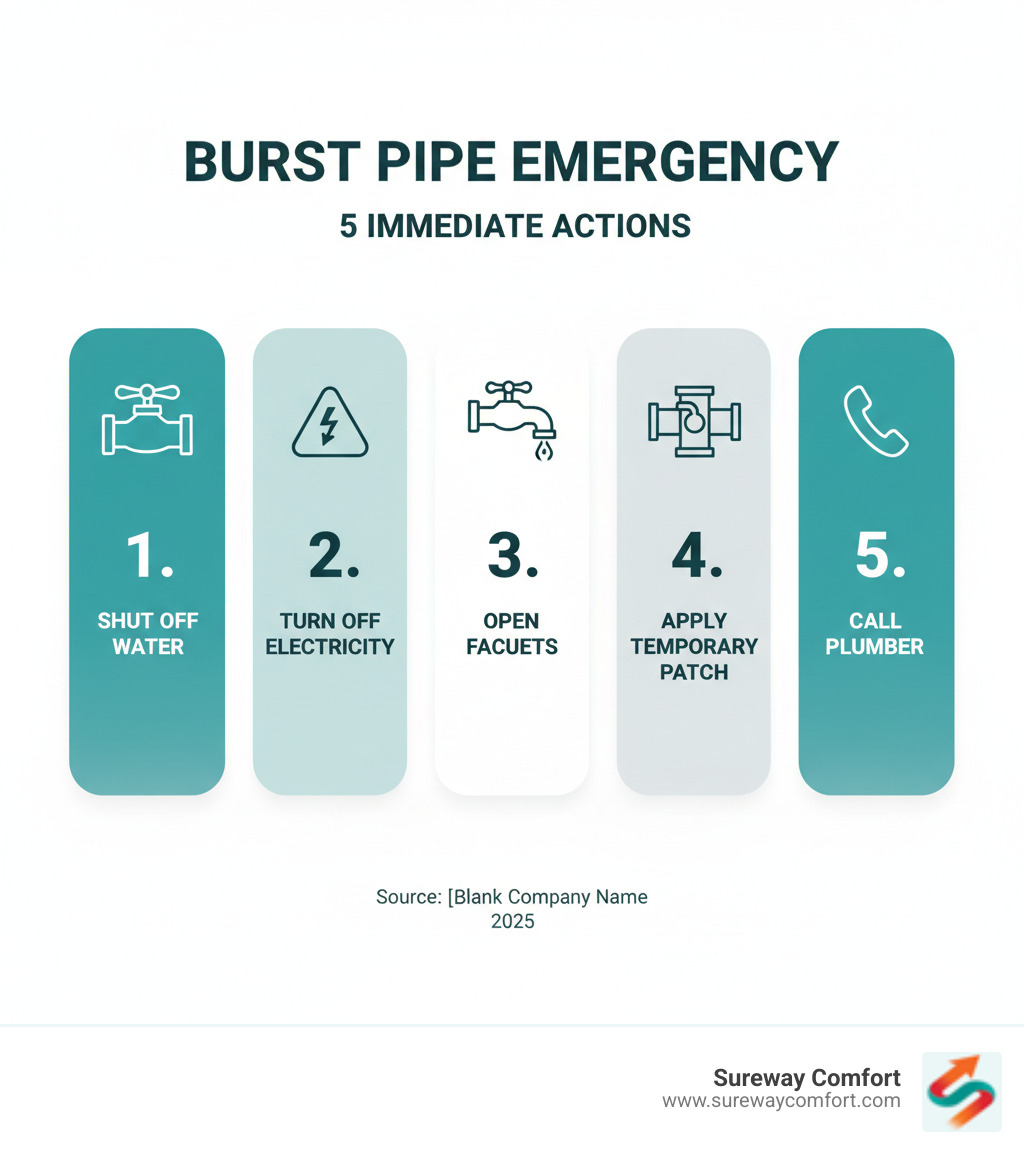
Emergency! Your First 5 Steps When a Pipe Bursts
When you hear that awful sound of rushing water or see a puddle spreading across your floor, your heart probably skips a beat. But take a deep breath - you've got this. The next few minutes are crucial for minimizing damage and getting your burst pipe repair situation under control.
Think of these steps as your emergency playbook. Every second counts, but panic won't help anyone. Let's walk through exactly what you need to do, step by step.
Step 1: Shut Off the Main Water Supply
This is your number one priority - no exceptions. Before you do anything else, you need to stop that water from flowing.
Your main water shut-off valve is like the emergency brake for your entire plumbing system. Most homes have this valve on the foundation wall where the main water line enters your house. Check your basement first, then look in utility closets or near your water heater.
Once you find it, turn the valve clockwise until it won't turn anymore. Think "righty-tighty" - this will completely stop water flow to your entire home. The flooding should stop immediately, giving you breathing room to handle the rest.
Can't find your valve or it's not working? Don't worry - you can call your local water department to shut off service at the street. But finding your indoor valve is always faster and should be your first move.
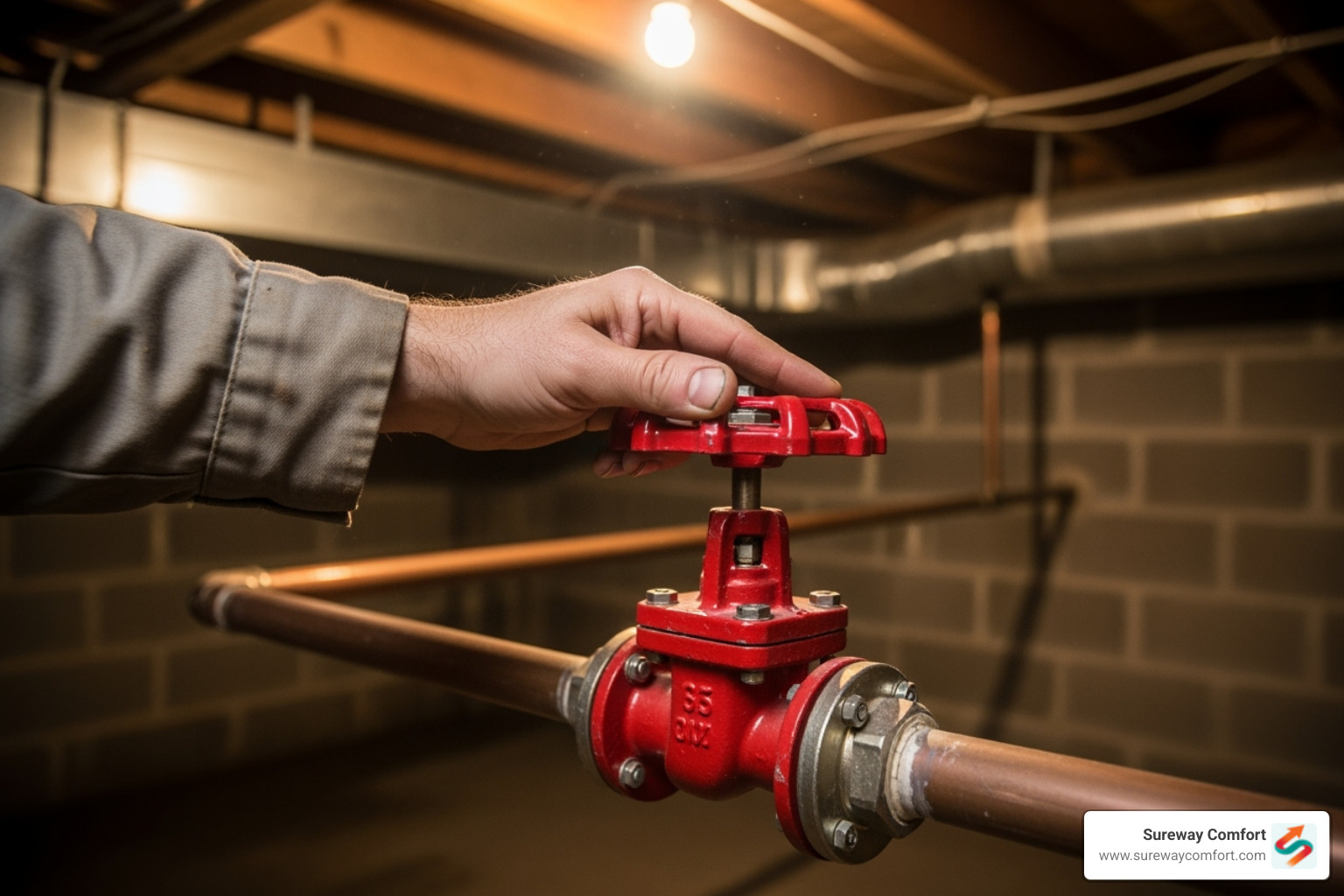
Step 2: Turn Off Electricity (If Needed)
Water and electricity are never friends. If your burst pipe is anywhere near electrical outlets, appliances, or your circuit breaker, you need to kill the power immediately.
Head to your electrical panel - it's usually in the basement, garage, or a utility area. Flip the main breaker to "off" for the affected area, or honestly, just shut off power to the whole house if you're not sure. Better safe than sorry.
If water has already reached electrical equipment, don't touch anything. Step away and call a licensed electrician once you've handled the water emergency. Your safety is way more important than saving a few minutes.
Step 3: Drain the System
Even with the main water off, there's still plenty of water sitting in your pipes just waiting to leak out. Let's get rid of it before it causes more damage.
Start by opening all your cold water faucets, beginning with the lowest ones in your home (basement or first floor). Then flush your toilets a couple times - this helps release pressure and gets water moving out of the system.
Once the cold water stops flowing, open your hot water taps too. Just make sure to turn off your water heater first - you don't want it trying to heat an empty tank.
This whole process relieves pressure in your pipes and drains out water that would otherwise keep dripping from your burst pipe. It's like deflating a balloon - much easier to work with when there's no pressure behind it.
Step 4: Make a Temporary Repair
Now comes the MacGyver moment. You're not trying to fix this permanently - you're just buying time until professional burst pipe repair can happen.
A pipe clamp is your best friend if you have one. Just wrap the rubber sleeve around the burst section and tighten the metal clamp. No pipe clamp? Get creative with what you have.
Try wrapping thick rubber (an old inner tube works great) around the break and securing it with a C-clamp. Even heavy-duty duct tape wrapped tightly can slow down a leak, though it's definitely not a long-term solution.
Don't forget to put a bucket under the leak to catch whatever water still escapes. And move anything valuable out of the splash zone - water has a way of finding things you don't want it to touch.
This is just a temporary patch to get you through until the pros arrive. But it can make the difference between a manageable mess and a complete disaster.
Why Pipes Burst: Common Causes and Warning Signs
When your pipes suddenly burst, it might feel like terrible luck striking out of nowhere. But the truth is, burst pipe repair emergencies are usually the result of your plumbing system sending distress signals that have been building up over time.
The materials your pipes are made from tell a big part of the story. If you're living in an older home, you might have galvanized steel pipes that have been quietly corroding away for decades. These metal pipes develop rust and mineral buildup that weakens them from the inside out. Copper pipes are generally more durable, but they're not invincible - certain water conditions can cause them to corrode too. The newer PEX pipes are much more forgiving, especially when temperatures drop, but even they have their breaking point.
Beyond the pipe material itself, several factors can push your plumbing system to its limit. High water pressure is a silent destroyer - if your home's pressure consistently runs above 70 psi, it's like having someone constantly hammering on your pipes from the inside. Clogs create dangerous pressure buildups that can turn a simple blockage into a plumbing disaster. When your home's foundation shifts naturally over time, it can twist and stress pipes until they crack.
Sometimes the damage is more obvious. Physical damage from construction work, ambitious DIY projects, or even tree roots can directly compromise your pipes. And corrosion - especially in homes with well water or unusual pH levels - slowly eats away at pipe walls until they're paper-thin.
The #1 Culprit: Freezing Temperatures
Here's the big troublemaker: freezing temperatures. When water turns to ice inside your pipes, it expands with tremendous force - enough to split even the strongest materials. This isn't just about really cold days, either. The pipes most at risk are hiding in unheated spaces like your basement, crawl space, or garage.
Attics are particularly sneaky trouble spots. Those pipes running overhead are essentially sitting outside when winter hits. Exterior walls without proper insulation create the same problem - your pipes are basically camping out in the cold.
The really frustrating part? The actual burst often happens when things start warming up. As the ice melts, all that water comes rushing through the damaged pipe at once. It's like your plumbing system is playing a cruel joke on you.
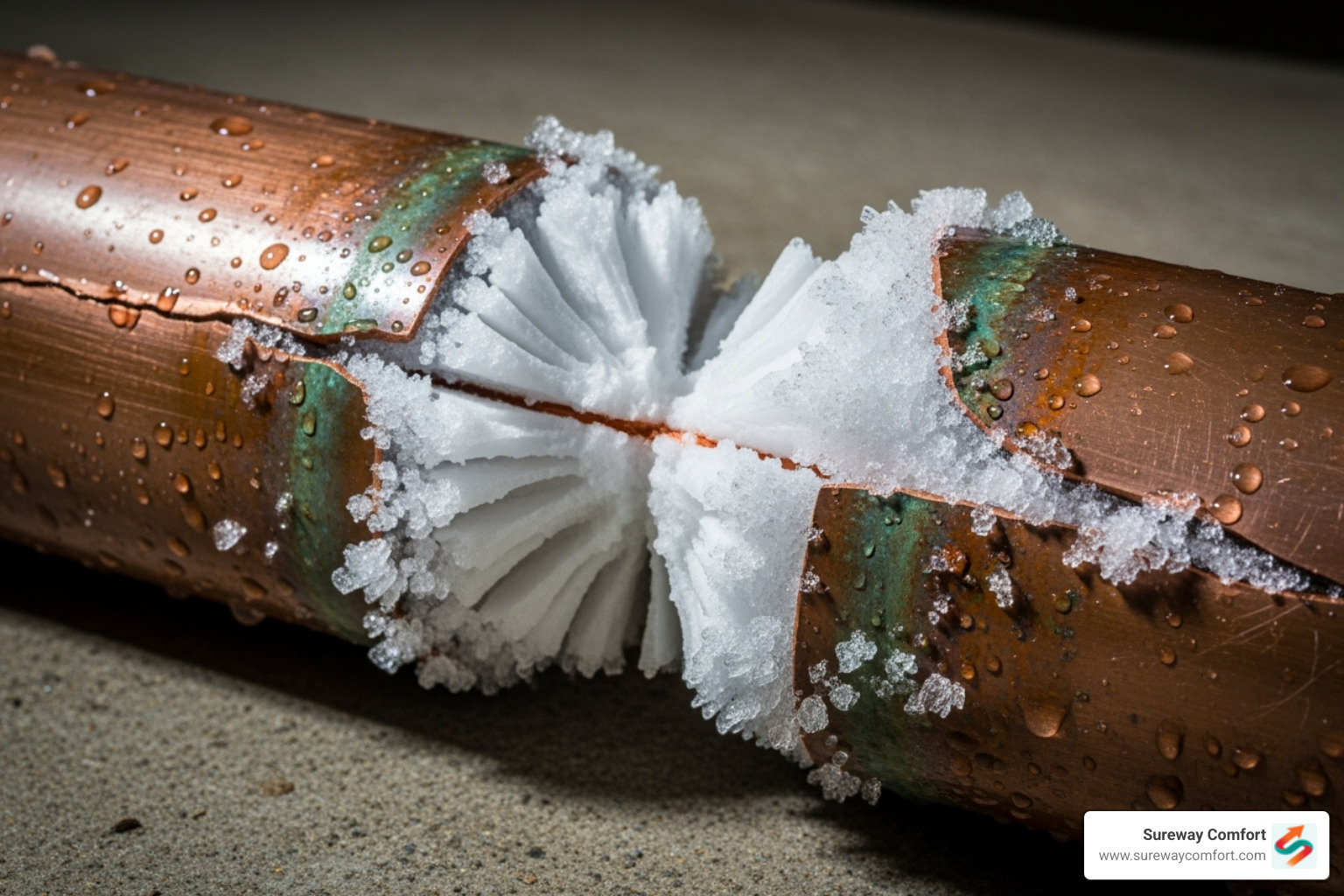
Telltale Signs of a Burst Pipe
Your plumbing system usually tries to warn you before things go completely sideways. Learning to recognize these signs can save you from a full-blown flood and expensive burst pipe repair.
Sudden water pressure drops throughout your home are like your pipes screaming for help. If your shower suddenly feels like a gentle drizzle when it used to have great pressure, something's definitely wrong.
Discolored water is another red flag that's hard to miss. When your tap water comes out looking rusty or brownish, or has that metallic smell, it's telling you that corrosion is eating away at your pipes from the inside.
Listen carefully to your home - it's trying to tell you something. Strange noises like gurgling, hissing, or the sound of water running when all your taps are off are clear warnings. Those mysterious sounds behind your walls aren't ghosts - they're leaks waiting to become bigger problems.
Damp spots on walls or ceiling stains are visual proof that water is going where it shouldn't. Water has a sneaky way of traveling through your home's structure, so damage might show up far from where the actual problem is hiding.
Don't ignore that musty smell in your basement or utility room. That damp odor often means water has been quietly leaking and potentially creating mold conditions.
Finally, keep an eye on your water bills. If your usage hasn't changed but your bill suddenly spikes, you're probably paying for water that's escaping somewhere in your system.
When you notice any of these warning signs, especially multiple ones together, it's time to take action quickly. At Sureway Comfort, we've helped countless homeowners in Bridgeville, South Fayette, Upper St. Clair, Mt. Lebanon, McDonald, Scott Township, Canonsburg, and Bethel Park catch these problems before they turn into major disasters. Contact us if you're seeing any of these warning signs - it's much easier (and less expensive) to fix a small leak than to deal with a burst pipe emergency.
Your Complete Guide to Burst Pipe Repair
Once you've taken those critical first steps to stop the water flow and protect your home, it's time to think about the actual burst pipe repair. While watching water spray everywhere might make you want to grab the nearest wrench and dive in, it's important to understand what you're getting into before attempting any DIY fixes.
The reality is that burst pipe repair can be tricky business. What looks like a simple crack might be hiding bigger problems, and an improper repair can lead to future leaks, water damage, or even health hazards from mold growth. For any significant damage or pipes hidden inside walls, calling a professional is almost always your best bet.
That said, if you're dealing with an accessible, straightforward break and you're comfortable with basic plumbing tasks, some DIY methods can provide a permanent solution. Just remember to prioritize safety first. Always wear appropriate protective gear, especially eye protection, when cutting pipes or working with heat from soldering equipment.
Permanent DIY Burst Pipe Repair Methods
For homeowners ready to tackle their own burst pipe repair, you have two main options that can provide lasting results: push-to-connect fittings or traditional soldering for copper pipes.
| Method | Push-to-Connect Fittings | Soldering |
|---|---|---|
| Pros | No special tools needed, works on multiple pipe types, beginner-friendly, instant connection | Strong permanent bond, professional appearance, lower long-term cost |
| Cons | More expensive per fitting, some codes don't allow them | Requires torch and flux, learning curve, fire hazard if done incorrectly |
| Best For | Emergency repairs, DIY beginners, mixed pipe materials | Copper pipes, permanent installations, experienced DIYers |
Push-to-connect fittings have revolutionized DIY plumbing repairs. These clever little devices, like push-to-connect fittings for easy repairs, simply slide onto clean, straight-cut pipe ends and create an instant watertight seal. You'll need a pipe cutter to make clean cuts and a deburring tool to smooth the edges, but that's about it for special equipment.
The process is surprisingly straightforward: measure the damaged section, cut out the bad pipe, measure your new replacement piece carefully, and connect everything with the push-fit connectors. The key is making sure your cuts are perfectly straight and the pipe ends are completely clean.
Soldering, on the other hand, is the traditional method that creates incredibly strong, permanent connections. You'll need flux (a cleaning paste), a torch, and some practice to get it right. The process involves heating the joint and applying solder, which melts and flows into the connection to create a sealed bond.
While soldering produces professional-quality results, it does come with a learning curve and fire safety considerations. If you've never soldered before, a burst pipe emergency probably isn't the best time to learn.
Knowing When to Call a Professional for Burst Pipe Repair
Sometimes, despite your best DIY intentions, it's time to call in the experts. Major flooding that affects multiple rooms or floors is usually beyond what most homeowners should tackle alone. The same goes for hidden leaks inside walls – what seems like a small problem might require opening up drywall and dealing with structural damage.
Main water line breaks are definitely professional territory. These pipes carry high pressure and often require special tools and permits to repair properly. If you're dealing with sewer line issues or need trenchless repair methods, you're looking at specialized equipment that most DIYers simply don't have access to.
Here's the thing: if you lack the proper tools or experience, or if you're feeling overwhelmed by the scope of the damage, there's no shame in calling for help. A botched DIY repair can end up costing much more than hiring a professional from the start.
At Sureway Comfort, our experienced technicians have seen it all when it comes to burst pipe repair. We use advanced leak detection technology to spot problems quickly and provide lasting solutions that protect your home. Whether you're dealing with an emergency situation or want to prevent future pipe failures, contact us for expert plumbing assistance – we're here to help homeowners throughout Bridgeville, South Fayette, Upper St. Clair, Mt. Lebanon, McDonald, Scott Township, Canonsburg, and Bethel Park get their plumbing back on track.



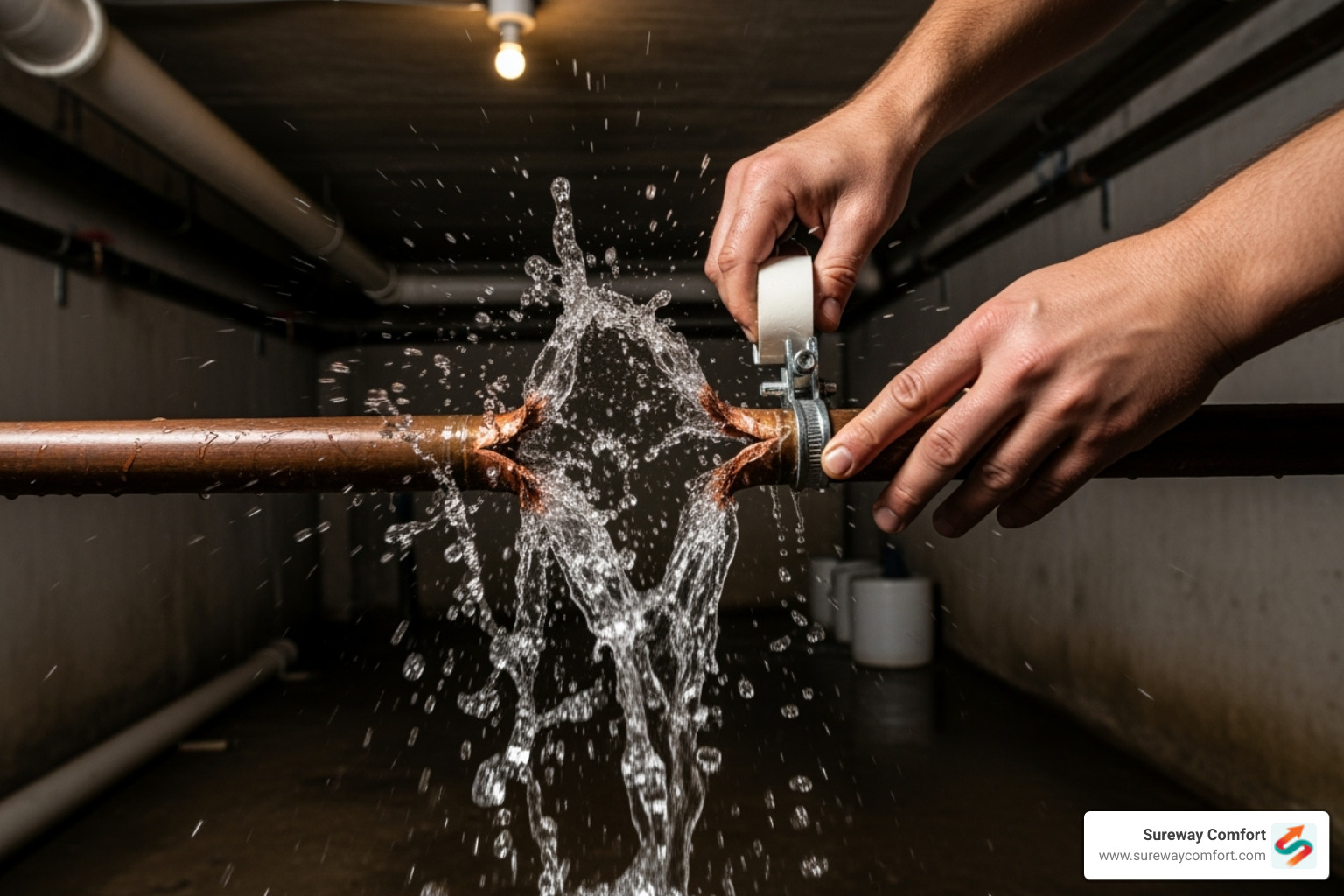
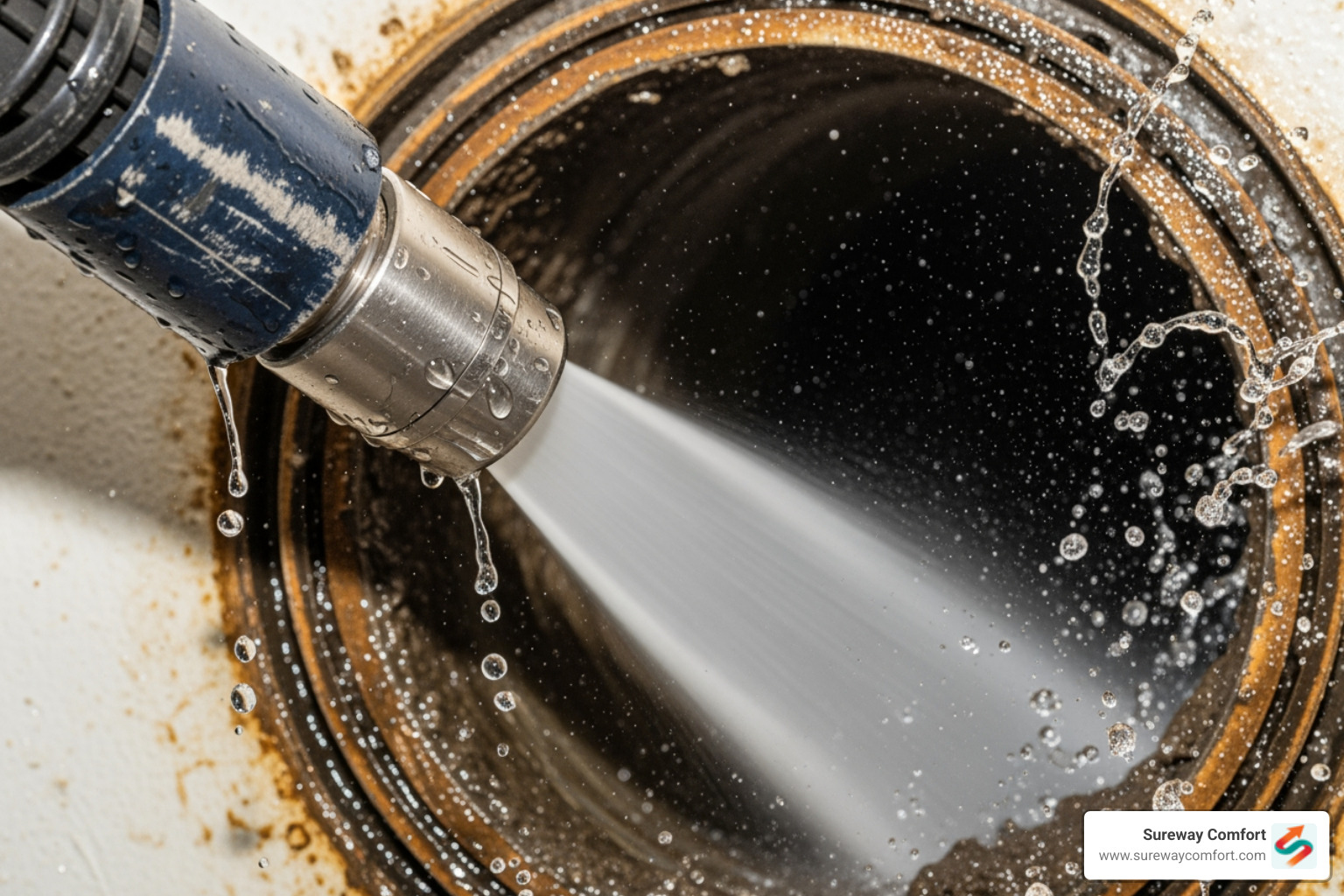























.avif)



